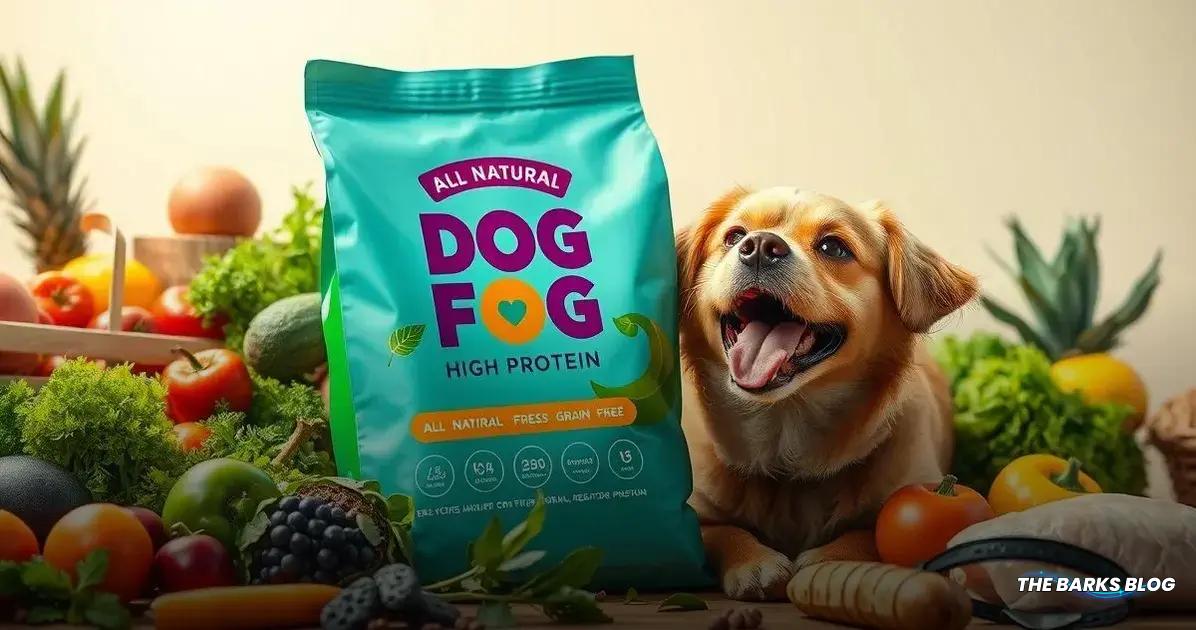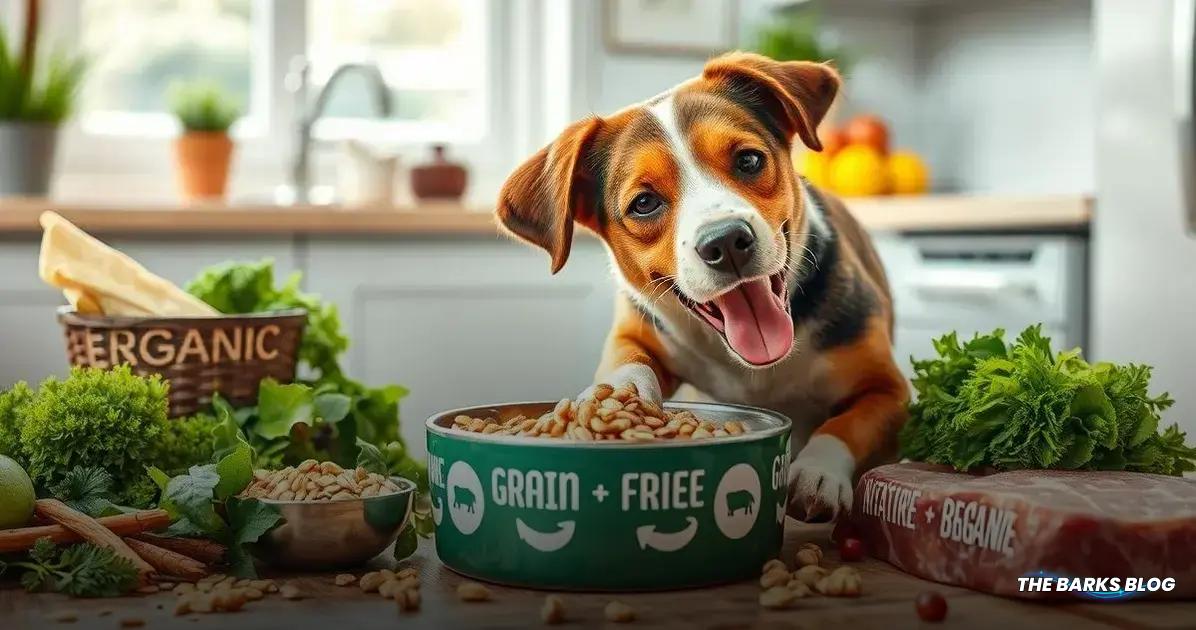Understanding dog food labels is crucial for ensuring your pet’s nutrition. Focus on the ingredient list, guaranteed analysis, and AAFCO nutritional adequacy statements. Be cautious of misleading terms like “grain-free” and “premium.” The USDA regulates “organic” ingredients, but overall nutritional value is key. Complete nutrition prevents health issues and ensures all necessary nutrients are provided. Always consult your veterinarian for personalized dietary advice and choose high-quality foods for your dog’s well-being.
In this guide, we’ll explore how to read dog food labels and what terms like “all-natural” or “grain-free” really mean.
Just like with human foods, sometimes a dog food label can be misleading. It’s essential to understand how to navigate these labels to ensure your precious pup is getting the right nutrition.

Understanding Dog Food Labels
Understanding dog food labels is crucial for any pet owner who wants to provide the best nutrition for their furry friends. The label is your first line of defense against marketing gimmicks and misleading claims. Here are some key components you should focus on:
1. Ingredient List
The ingredient list is typically the first place to start. Ingredients are listed in descending order by weight, meaning the first few items are the most significant in the food. Look for high-quality protein sources like chicken, beef, or fish as the first ingredient. Be wary of vague terms like “meat by-products” or “animal meal” which can indicate lower quality.
2. Guaranteed Analysis
This section provides a breakdown of the nutrients in the food, including protein, fat, fiber, and moisture content. It’s essential to compare these values with your dog’s specific dietary needs. For instance, active dogs may require higher protein levels, while older dogs may benefit from lower fat content.
3. Nutritional Adequacy Statement
Look for a statement from the Association of American Feed Control Officials (AAFCO) that indicates the food is complete and balanced for your dog’s life stage. This ensures that the food meets the minimum nutritional requirements.
4. Feeding Guidelines
Most dog food labels will provide feeding guidelines based on your dog’s weight and age. These recommendations are a good starting point, but you may need to adjust based on your dog’s activity level and metabolism.
5. Marketing Terms
Be cautious of marketing terms like “premium,” “natural,” or “holistic.” These terms are not regulated and can mean different things to different manufacturers. Always look for the specifics behind these claims and check the ingredient list and nutritional information.
In summary, understanding dog food labels requires careful reading and consideration. By familiarizing yourself with these components, you can make informed decisions that will help keep your furry companion healthy and happy.

Common Misleading Terms
When it comes to dog food labels, some terms can be quite misleading. Here are some common phrases you might encounter and what they really mean:
1. Grain-Free
While grain-free diets have gained popularity, they are not necessary for all dogs. Many dogs can digest grains without any issues. Grain-free dog food is primarily marketed towards those who believe grains are harmful, but this is often a misconception. Consult with your veterinarian before making any drastic dietary changes.
2. All-Natural
The term “all-natural” is often used to create a perception of healthiness, but it lacks a formal definition in pet food regulations. Just because a product claims to be all-natural doesn’t mean it’s free from preservatives or artificial ingredients. Always check the ingredient list for any synthetic additives.
3. Premium
“Premium” is a term that is not regulated, meaning any brand can label their food as such. While it might imply higher quality, it doesn’t guarantee better nutrition. To truly assess a food’s quality, look at the ingredient list and nutritional adequacy statements rather than relying on marketing terms.
4. Human-Grade
Human-grade dog food suggests that the ingredients are fit for human consumption. However, this term can be misleading. Just because the food meets human standards doesn’t mean it meets the specific nutritional needs of dogs. It’s essential to ensure that the food is formulated for canine health.
5. Holistic
The term “holistic” implies a more comprehensive approach to pet nutrition, but it isn’t regulated either. Holistic foods can still contain low-quality ingredients. Always verify the quality of the ingredients and the nutritional profile rather than relying on the label.
6. Complete and Balanced
While this term indicates that the food meets AAFCO standards, it’s important to note that the quality of the ingredients can vary. Just because a food is labeled as complete and balanced doesn’t mean it’s the best choice for your dog. Always consider the source and quality of the ingredients.
In conclusion, being aware of these common misleading terms can help you make better choices for your dog’s nutrition. Always do your research and consult with your veterinarian to ensure your furry friend gets the best diet possible.

What Does Organic Mean?
The term “organic” is often seen on dog food labels, but it can be confusing. Here’s what you need to know about what organic really means in the context of pet food:
1. USDA Regulations
In the United States, the USDA regulates the use of the term “organic”. For a dog food to be labeled as organic, it must meet specific standards set by the USDA National Organic Program. This means that the ingredients must be grown without synthetic fertilizers, pesticides, or genetically modified organisms (GMOs).
2. Organic Certification
If a dog food product is certified organic, it will display the USDA Organic seal. This certification indicates that at least 95% of the ingredients are organic. However, it’s important to note that not all ingredients may meet this standard, so it’s wise to check the ingredient list for clarity.
3. Nutritional Value
While organic ingredients are often perceived as healthier, it’s crucial to remember that the nutritional value can still be compromised if the ingredients are cooked at high temperatures. Cooking can diminish the bioavailability of nutrients, regardless of whether they are organic.
4. Misleading Claims
Some manufacturers may use the term “organic” loosely. For example, if a product contains just one organic ingredient, it might be marketed as organic, even if the rest of the ingredients are not. Always look for the USDA seal and check the ingredient list to ensure the majority of the product is genuinely organic.
5. Organic vs. Conventional
Choosing organic dog food can be beneficial, especially for dogs with sensitivities or allergies. However, it’s not a necessity for every dog. Conventional dog foods can also provide balanced nutrition. The decision should be based on your dog’s specific needs, preferences, and any advice from your veterinarian.
In summary, understanding the term “organic” is essential for making informed choices about your dog’s diet. Always look for proper certification and consider the overall nutritional profile of the food rather than just the label claims.

Importance of Complete Nutrition
Complete nutrition is vital for your dog’s health and well-being. When selecting dog food, it’s crucial to ensure it meets the nutritional requirements necessary for your furry friend to thrive. Here’s why complete nutrition matters:
1. Essential Nutrients
A dog’s diet must include a balanced mix of proteins, fats, carbohydrates, vitamins, and minerals. Each of these nutrients plays a specific role in maintaining health. For instance, protein is essential for muscle development and repair, while fats provide energy and support skin and coat health.
2. Life Stage Considerations
Different life stages—puppy, adult, and senior—have varying nutritional requirements. Puppies need higher protein and fat content for growth, while senior dogs may require fewer calories and more fiber to aid digestion. Choosing a food labeled as “complete and balanced” for your dog’s specific life stage ensures they receive the appropriate nutrients.
3. Prevention of Health Issues
Feeding your dog a nutritionally complete diet can help prevent various health issues, such as obesity, diabetes, and joint problems. For example, a diet rich in omega fatty acids can support joint health, while a balanced intake of vitamins can boost the immune system.
4. Quality of Ingredients
Not all dog foods labeled as “complete” are created equal. The quality of ingredients matters significantly. High-quality ingredients are more likely to provide the necessary nutrients in bioavailable forms, which means your dog can absorb and utilize them effectively. Always look for reputable brands that source their ingredients responsibly.
5. Consult Your Veterinarian
When in doubt about your dog’s nutritional needs, consulting with a veterinarian is essential. They can provide tailored advice based on your dog’s age, breed, activity level, and any specific health concerns. This personalized guidance ensures that you choose the best food for your pet’s unique needs.
In conclusion, ensuring your dog receives complete nutrition is fundamental for their health, longevity, and quality of life. By selecting high-quality, complete dog food and consulting with your veterinarian, you can help your furry friend lead a happy and healthy life.
Conclusion
Understanding dog food labels is crucial for making informed decisions about your pet’s nutrition. By recognizing common misleading terms, knowing what organic really means, and appreciating the importance of complete nutrition, you can ensure that your furry friend receives the best possible diet.
Always prioritize high-quality ingredients and consult with your veterinarian to tailor your dog’s diet to their unique needs. With the right knowledge and resources, you can confidently choose the best food for your beloved companion, ensuring they lead a healthy and happy life.
FAQ – Frequently Asked Questions about Dog Food Labels
What should I look for on a dog food label?
Look for a clear ingredient list, guaranteed analysis for nutrients, and a nutritional adequacy statement from AAFCO that confirms the food is complete and balanced.
What does it mean if a dog food is labeled as ‘grain-free’?
Grain-free means that the food does not contain grains such as wheat, corn, or rice. However, it’s important to note that not all dogs need a grain-free diet; consult your veterinarian before making changes.
Is organic dog food better for my dog?
Organic dog food must meet USDA standards, which can indicate higher quality ingredients. However, it’s not necessarily better for all dogs. Assess your dog’s specific needs and consult your veterinarian.
What does ‘complete and balanced’ mean on dog food?
‘Complete and balanced’ indicates that the food meets the minimum nutritional requirements set by AAFCO for your dog’s life stage, ensuring it provides all essential nutrients.
Are marketing terms like ‘premium’ and ‘natural’ regulated?
No, terms like ‘premium’ and ‘natural’ are not regulated, meaning they can vary significantly between brands. Always check the ingredient list and nutritional information for clarity.
How can I ensure my dog is getting the right nutrition?
To ensure your dog gets the right nutrition, choose high-quality dog food that meets AAFCO standards, consult with your veterinarian, and adjust their diet based on their life stage and health needs.




